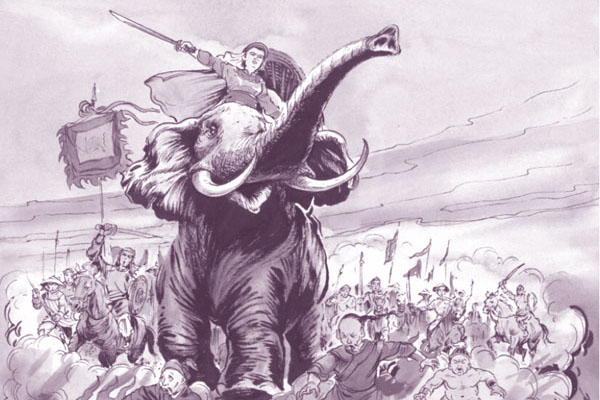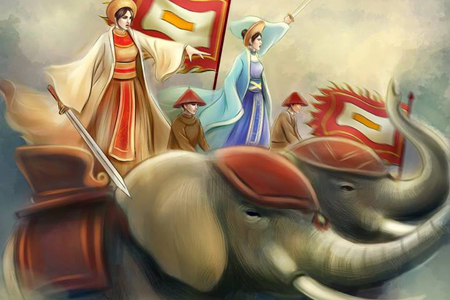Along the centuries Vietnamese patriotic traditions have crystallized in great figures, the most moving and most popular of them being the Trung Sisters.
The veritable Chinese conquest dates back to the year 111 before Christ. In the year 40, Trung Trac, the daughter of a family of indigenous seigneurs (lac hau) raised the standard of revolt, assisted by her husband Thi Sach and her younger sister Trung Nhi, together with other Lac seigneurs. The cruel Chinese proconsul To Dinh (SuTing) fled. Trung Trac’s troops stormed 65 citadels, and she proclaimed herself queen. In the year 41, the Chinese court sent against her a veteran general, the battle-hardened Ma Vien (Ma Yuan). After winning some battles, the Trung Sisters were defeated and died in the year 43. Legend has it that they drowned themselves in the river Hat (in lake Lang Bac, often confused with the West Lake, according to another version). Old annals told the story that the assassination of Thi Sach by To Dinh sparked off his wife Trung Trac’s rebellion.
In any event, the epic of the Trung Sisters is engraved in all minds and all hearts, so much so that in the time of French rule as well as under Chinese domination, it took on the value of a symbol of patriotism. In modern times, all political parties and political figures of all persuasion, including the collaborationists, have claimed to be inspired by it.

Whence that fervor comes composed of veneration and affection which creates for the Sisters an outstanding place in the pantheon of heroes of national independence?
First of all, it is the element time. Two thousands years of worship, The Trung Sisters were the first to assert by the force of arms the cultural and national identity of the Viet formed in the first millennium before Christ (the Bronze Age) in the Red River basin in the midst of Southeast Asia. They defended the authentically Viet values, customs and habits, which were pre-Chinese, pre-Confucian the embryos of future "Vietnamity".
The second factor accounting for the lasting prestige of the Trung Sisters and the popular affection they enjoy is the fact that they were women. A woman taking up arms to avenge her husband, women warriors, not only the two Sisters but also their mother, their valorous female soldiers and commanders - that causes the imagination of the masses to blaze up. In the days of the two heroines matriarchy had not disappeared in pre-Chinese Vietnam. Later analysts under the influence of patriarchal Confucianism were to change certain historical data concerning the Trung Sisters without being able to alter their memory.
In Hanoi and three neighboring provinces alone are counted two hundred temples dedicated to the Two Dames and their women lieutenants. According to legend, Trung Trac and Trung Nhi threw themselves into the river Hat, on whose banks the insurgent troops had assembled for a solemn catch before the start of the insurrection. Their bodies flouted downstream as far as Dong Nhan (now in the outskirts of Hanoi). The population erected a temple in their honor. It was ruined when the river flooded heavily. The building was moved to Dong Nhan village, now Dong Nhan Street, in Hanoi in 1819. Each year a ceremony in honor of the Trung Sisters is held in great pomp on the 3rd day of the 5th lunar month.



